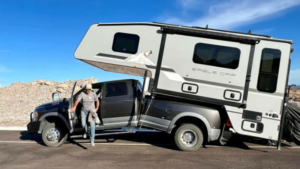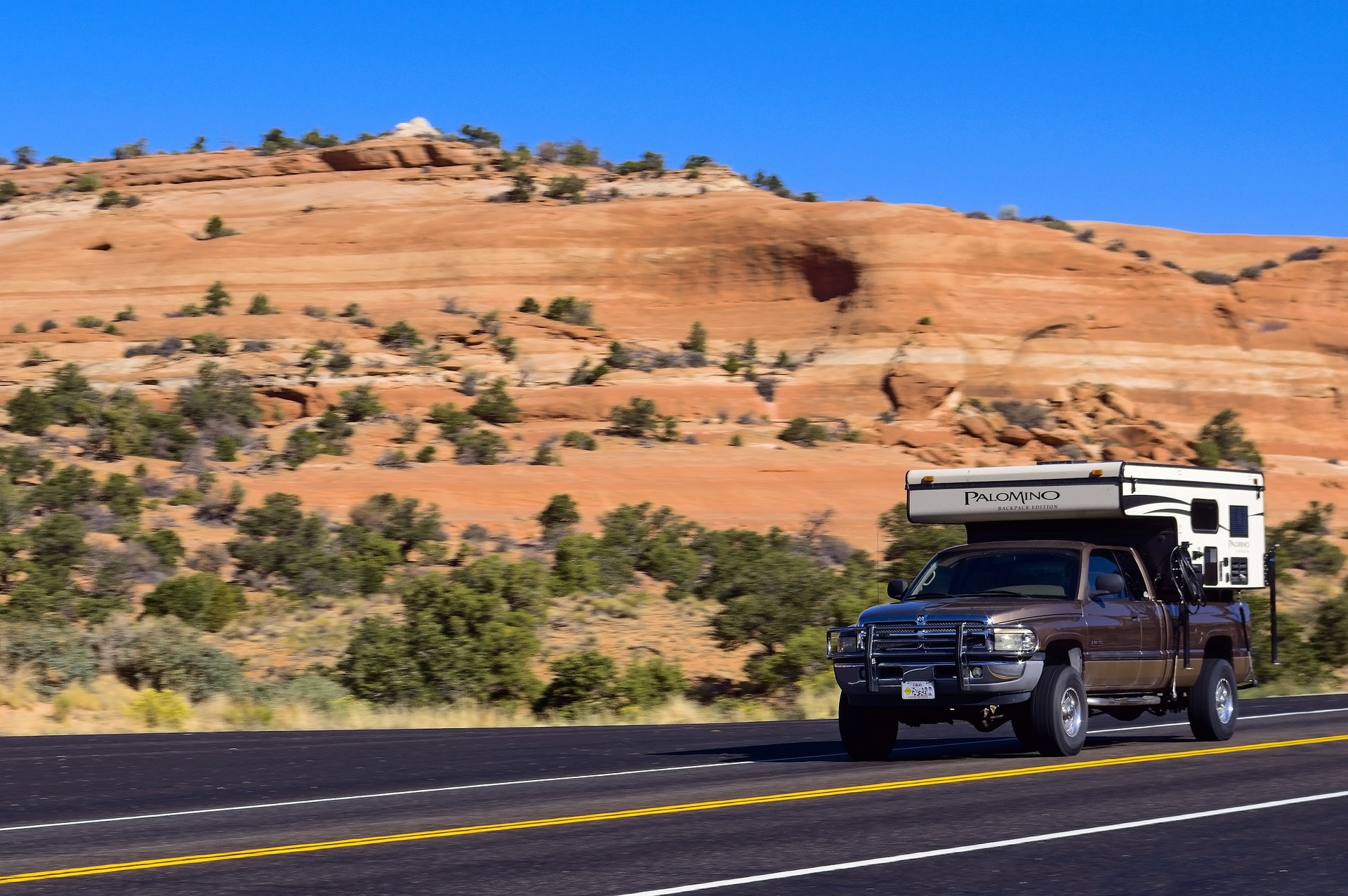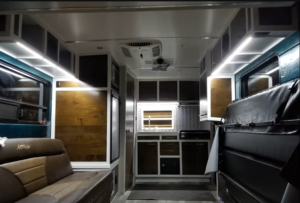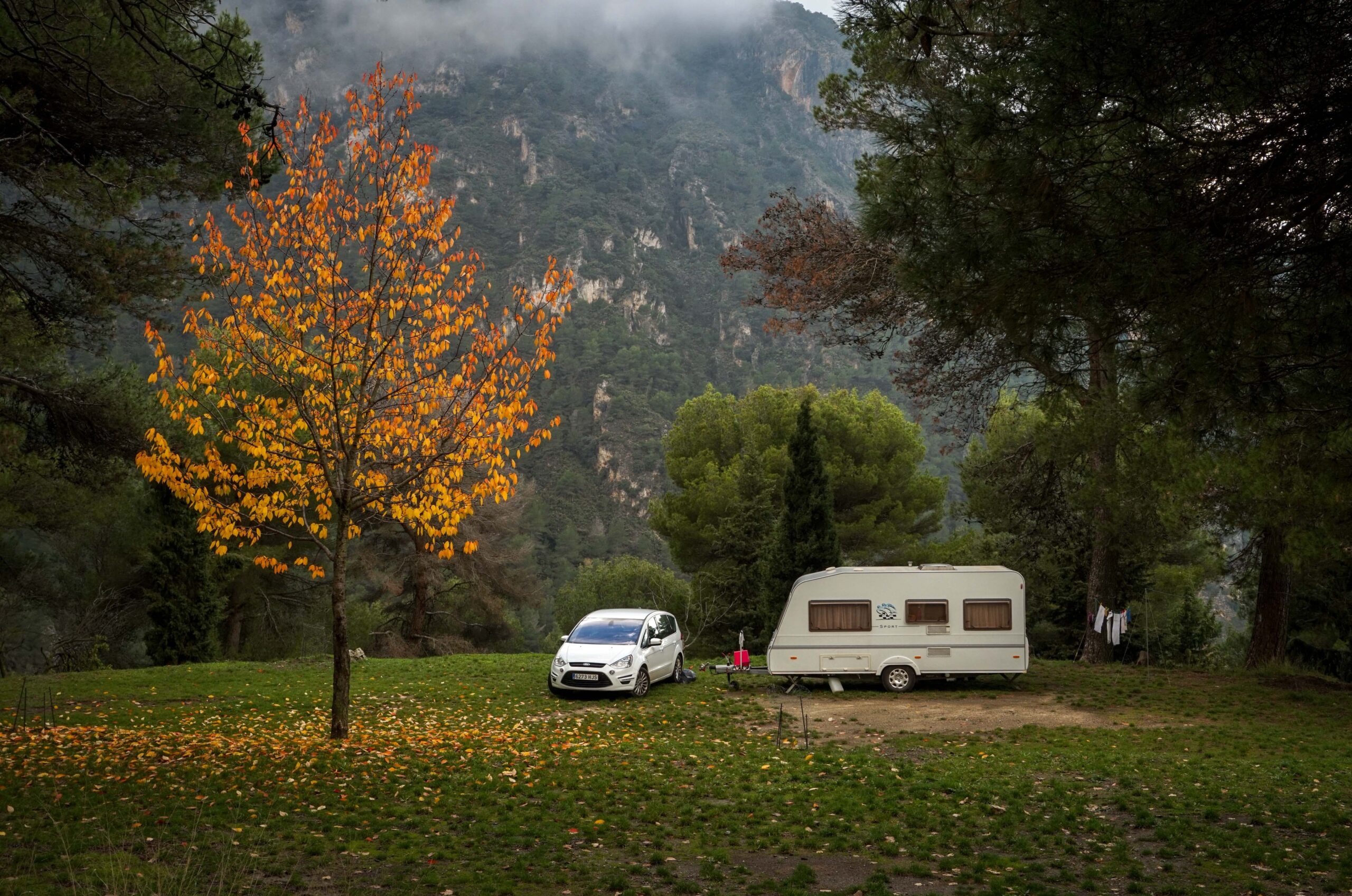If you have a truck, but don’t want to be bothered hauling a trailer, and sleeping in the bed with just a camper top doesn’t quite work for you, then consider the marriage of the two: a slide-in. It gives you the head-height of a camper while staying contained to the back of your truck.
BUT, before you buy a slide-in, and especially before you make one, make sure you know what amount of weight your truck can carry (it’s in the owner’s manual, but if you don’t have a manual, a dealership should be able to look it up for you based on your VIN; carry capacity will vary based on options, not just make and model). And don’t forget that you will be adding weight in addition to your slide-in. So there’s the weight of the slide-in, plus the weight of all the gear and food and water and other supplies you put in it, plus the weight of all the people riding in the truck and all the supplies and maintenance equipment, etc. in the cab of the truck itself. If you’re unsure about the different types of weight limits (e.g. weight the truck can carry, weight the tailgate can carry, dry weight, gross weight, etc.), ask at a dealership and make sure you understand how much camper you can have. Don’t be this guy:

Weight and length both can be a factor. This guy has what looks like a motorcycle attached to the back of a slide-in that already overhangs the tailgate. That’s a lot of unsupported weight in the back.
To get started, here is a video by a solo woman as she and her dog take a slide-in camper out for its maiden trip. She has some good advice for what works and what doesn’t work, and her trip planning to avoid bad/cold weather is something you will probably also need to think about if you’re planning on moving around. The one thing you should take from this is that you definitely need to try a short stint in your camper (regardless of what kind it is) so you can see what you need to change before you hit the open road for a year.
It’s not easy to find slide-ins that word for small, light-duty trucks like a Ford Ranger or Nissan Frontier, but this one is made for those size trucks. The most impressive part is the huge fridge it has relative to its size. Drawbacks are that you have to set up the table and then store it on top of your bed when it’s not in use. A pull-out table that slots under the bed would be better. Also, there’s no countertop. Presumably the table can be pushed up against the seats and you would have enough room to use a portable stove or hot plate on it while cooking, then slide the table over so you can sit down on the bench and use it to eat. If it were me, I would find a way to install a sliding drawer in the bottom of one of the cabinets next to the sink or cut a hole above a lower cabinet and create a pull-out shelf that I could use for prep work or my stove. This is definitely a one-person camper, because despite the fact that it has a queen bed and the bench can make a child’s bed, there’s really not space for two people to function long-term. But for 1 person, with some modifications, this could be an okay living space.
This is another slide-in made for a small truck, but this is a pop-up model. It has a sink and built-in stove and actual countertop area. It can accommodate a small refrigerator, but is more setup for a cooler or cooler-style fridge. I like that there’s a door in the step to the bed that can contain a potty. The drawbacks are the support poles for the roof look like they would make getting out of bed more of a challenge, the heater sticks out into the precious floor area (and what’s the likelihood that it’s hot and you potentially hit your leg on it?) and I see no sign of a table. You’d have to make do with something like TV trays when you want to sit and eat or use your laptop.
This homemade slide-in works on a small/mid-size truck. It doesn’t have an obvious kitchen or bathroom set-up, but the design is so basic, it wouldn’t be hard to figure out where to store and set up that kind of equipment. Doors allowing access down into the dead space in the truck bed would be a good place to start with storing a propane stove, dishpan, and the like. A trashcan could possibly be put into one of these access holes, creating a potty option as well.
This homemade slide in for a small Toyota Tacoma is a unique bachelor pad for an outdoorsy guy who travels to do firefighter (I presume wildfire) work. He bought a pop-up roof tent and modified it to fit on top of his homemade slide. This gives him more interior head height. He also is able to mount kayaks on the roof/sides of the slide-in. A small wood burning stove provides dry heat for winter and drying out his wet gear. Since he mainly goes off-road, he makes a good point about the drawers in his previous rig becoming misaligned. So for this build, he just made cubbyholes and covered them with stretchy cargo netting. It’s not the neatest look in the world, but it’s certainly practical and it reduces the weight of the build to be sans doors and drawers.
This homemade slide-in is for a medium-sized truck and, unlike the previous one, features an over-the-cab bed, which really increases the amount of space you have in the bed for seating, a kitchen, storage, etc. If you’re not planning on spending a lot of time entertaining friends, you could reduce the seating to one bench and use the other space for more storage and countertop.
This is the largest of the homemade slide-ins, with an extra-deep over-the-cab bed, overhanging side walls, and a porch that sticks out past even the tailgate. It has the largest kitchen set-up, has a dining table, a wood stove, and storage under the bed as well as behind it. It was built to go off-road, as the owners like to ski.
If you want a slide-in that doesn’t look like a slide-in, you can always build a tiny cabin in the back of your truck. This one features a wood-burning stove and can even withstand off-roading in Alaska.
This house in the back of a truck is a budget build, coming in at under $900. They wanted it to look glam, but if you go with a more rustic look, you could make even more use of those free pallets. They also came up with a clever way to take the camper on and off the truck without the use of heavy and expensive jacks.
Personally, I think this house is too tall relative to the size of the truck (especially for freeway speeds, although they said it hauled fine at 60 mph), but I understand they made it that way to accommodate two men. If you’re solo, then you can make it considerably shorter. (This will also lessen the weight, making it more manageable for a smaller truck.)
Also, as this is meant to be a weekend camper, not a tiny house on wheels, they left a lot of precious space empty, like the holes that were created between the back of the cab and the wheel wells (a good place to tuck out-of-season stuff or repair supplies that aren’t need often). A shelf above the windows on the kitchen side would not only create space for storage cubbies above, but you could also mount a smaller TV underneath it that folds up and out of the way. Then the counter where their TV is sitting could be raised and used as a prep area, and you could extend it further with a pop-up or pull-out counter that could double as a table/desk for the bottom bunk, and you could store a potty underneath it.
Something I saw mentioned in the comments is that the extension cable they used for their quick and dirty wiring is not heavy enough for a space heater. My mother has a camper at my house at the moment and she ran into this same problem when she ran a space heater on too-small a cord; it melted the prongs in the outlet and we almost never got it out. She upgraded to a heavier cord and it’s been fine since then. So don’t cheap-out when it comes to your electrical wiring. If you’re going to be camping without access to electricity, then a tiny portable wood stove would probably be your best option for heating and a solar generator should be plenty for the rest of your needs. (It won’t run an A/C, but it will run fans or a swamp cooler if your climate supports one.)
Another person mentioned the dark colors they used for the exterior will absorb more heat. That’s probably not a bad thing if you’re in Canada or Alaska, but definitely not the best idea if you’re in the South or Southwest. Choose your paints according to the climate in the area where you think you will spend most of your time.
If you’re really ambitious as far as construction goes, and you can either get a decent price on a flat-bed truck, or you have the ability to take the bed off a full-size truck,then you can build a cabin on the back of your truck instead of a slide-in.
The flat-bed rig that these folks are using, especially with its upgrades, are going to be out of most people’s price range, but you can get a lot of inspiration from how they updated their old truck slide-in to make it look really nice and new.
Do you want something with a bit more space than a slide-in affords? Check out this post to explore all your camper options: Highway Homes: Exploring Options for Camper Living
Is a camper not the right option for your budget or current vehicle, but you want the nomad life? There are plenty of other alternatives available: On the Road Again – Exploring Nomadic Housing Options


